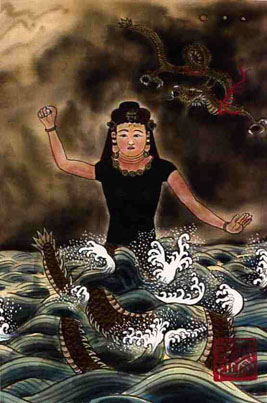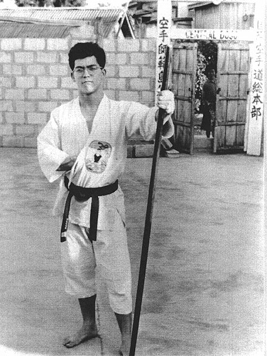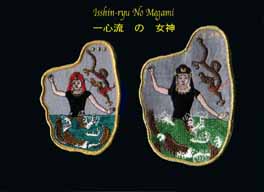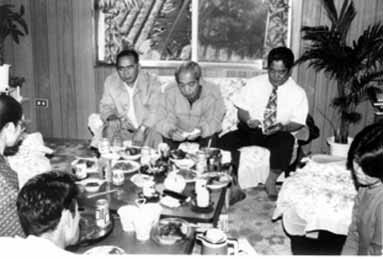The Megami Patch
Meanings of the Patch • The True Story of the Patch • Megami Summarized • Interview with Tatsuo StudentsGODDESS OF ISSHINRYU The Megami crest of the IsshinKai. Designed by Sensei A.J.Advincula as the 1st patch of Isshinryu Karate and authorized by Shimabuku Tatsuo, the crest has recently taken a new look for 2000 (left) in honor of Shimabuku Tatsuo. Unlike other Megami patches in production, the IsshinKai patch has no writing about or within. As Sensei Advincula explains, "Isshinryu" is represented within the symbolism of the crest. Copyright - A.J.
The original and traditional Megami patch as designed by sensei Advincula. Different organizations make their own emblem designs, but in every emblem you can see the Megami. Not just a nice looking patch for it incorporates the thoughts of our founder and the ideals of our system
 The "Isshinryu No Megami" (Goddess of Isshinryu). The vision of Shimabuku Tatsuo Sensei to represent his Isshinryu Karate system.
The "Isshinryu No Megami" (Goddess of Isshinryu). The vision of Shimabuku Tatsuo Sensei to represent his Isshinryu Karate system.
The patch or crest worn by Isshinryu karateka often raises admiration and curiosity. The patch is based on a day dream Tatsuo Shimabuku had in the fifties while he was creating his karate style. This dream was the missing piece in the puzzle called Isshinryu. The patch is often called Mizu Gami, which means 'water goddess'. Originally the Isshinryu emblem was called 'Isshinryu No Megami', which means 'Goddess of Isshinryu'. However; most Isshinryu karateka incorrectly call it Mizu Gami, or 'Water Goddess'. Master Eiko Kaneshi, Tatsuo's right-hand-man who is a Shinto priest when asked if it was 'Mizu Gami' said it has nothing to do with water. Isshinryu no Megami or Megami for short, is correct. This is collaborated by Marien Jumelet who asked Shinsho Shimabuku and Kensho Tokumura what was the correct name. The goddes is the Goddess of Isshinryu karate and not the goddess of water.
 Arcenio J, Advincula, an American student of Sensei, created the Megami-patch in 1961 with Tatsuo Shimabuku's approval. As model he used Tatsuo's picture of the goddess. The shape of the emblem is as the vertical fist of Isshinryu, the trademark of this remarkable karate style.
Arcenio J, Advincula, an American student of Sensei, created the Megami-patch in 1961 with Tatsuo Shimabuku's approval. As model he used Tatsuo's picture of the goddess. The shape of the emblem is as the vertical fist of Isshinryu, the trademark of this remarkable karate style.
Advincula with the first Megami - patch he created in the Agena, Okinawa dojo in 1961. Advincula had returned to Okinawa on January 2, 1961 as a civilian after being discharged from the Marines in 1960. Photo was taken by Ed Johnson around February 1961. Notice in the background, Mrs. Shimabuku coming in the front entrance of the dojo.

• The Isshinryu Megami patch has many meanings. One could easily write a book about it for in it is found the beliefs of our founder, Master Tatsuo Shimabuku and what our style stands for. Here in short are some of the innermost meanings.
• The gold border stands for the vertical fist which is the primary trait of Isshinryu.
• The megami is half woman and half dragon. Her left hand is open, the universal symbol of peace or soft. Her right hand is closed in a Isshinryu fist, symbol of hard and is ready to be used in times of need to defend.
• The dragon ascends from the water into the sky or heaven, and stands for heaven. Tatsu means 'dragon' and our founders name Tatsuo, means 'dragon man'. For the dragon to many followers of Isshinryu is Master Shimabuku, who is the spirit of Isshinryu.
• The tiger in the headdress of the Megami stands for earth. Both dragon and tiger stands for heaven and earth.
• The dark background with the three stars shows it is night. Night symbolizes darkness which is the unknown.
• The three stars stands for all of Shimabuku's teachers who lighten the night bringing knowledge.
• The three stars are in one line (-), the Chinese and Japanese character for one. Sensei Shimabuku told his students on the introduction of Isshinryu that all things starts with one. The one stands for one in Isshinryu, for Isshinryu means 'One heart way'.
• The three stars can also mean: mind, body and spirit or any three things. Tatsuo said that Isshinryu was composed of three elements: Shorinryu, Gojuryu and Kobudo.
• The upper body / woman despicts that karate can be gentle as a woman. Symbolic of soft.
• The lower body / dragon shows that karate can be fierce as a dragon if needed. Symbolic of hard.
• The calm face of the goddess in a storm or in times of crises one must be calm, especially in times of danger.
• The turbulent water and storm or typhoon symbolizes danger which is always present.
• The kanji (Japanese characters) means : Isshinryu karate.
The Isshin-ryu patch was conceived by Arcenio J. Advincula with Tatsuo Shimabuku's permission in February 1961. Advincula started by asking Shimabuku for his permission to design a patch. Some American students were wearing patches they designed.
Some wore traditional horizontal fist patches. Some wore patches with a Shinto Tori. Still others wore a patch of Okinawa with Isshin-ryu written along the side. None of these patches reflected the true meaning of Isshin-ryu. Advincula wanted a patch depicting Shimabuku's goddess. He drew a design showing the goddess fighting a dragon. When Shimabuku saw the design, he laughed and said the design was wrong and started to explain his vision of the symbol to Advincula. It was a half woman and half dragon called Megami (goddess). Megami's forward hand is open, symbolic of peace and the back hand is closed, symbolic of force only if necessary for protection (yin/yang). The three stars are symbolic of Shimabuku's teachers who light up the unknown which is symbolized by the dark back-ground. The stars are also in the shape of the Japanese/Chinese character for one (-). Sensei Shimabuku said that all things must begin with one. Advincula believes that the three stars also mean one (ichi) or "is" in Isshin-ryu. Photo of Advincula wearing the first patch in the Agena dojo. Advincula had returned to Okinawa on January 2, 1961 as a civilian after being discharged from the Marines in 1960. Photo was taken by Ed Johnson around February 1961. Notice in the background, Mrs. Shimabuku coming in the front entrance of the dojo. While researching the subject, Advincula found that more than 3,000 years ago the Chinese discovered 28 constellations, one of which is "Hsin" or the heart with antares, sigma, and tau in the heart of scorpio. Advincula also believes that the three stars stand for one heart or Isshin which means whole heart. Dragon means ryu, which translates style, mode, or way. Therefore the name of our style, Isshin-ryu, translated one heart way, is hidden in the Megami's stars and dragon. Megami is in the midst of a typhoon, but her face remains calm. (yin/yang). The dragon, in Okinawan culture, is a benevolent creature and Okinawans believe that the dragon brings in the seasons. Tatsuo's name means dragon man. The dragon is also a symbol of heaven. In MegamiÕs headress there is a tiger, which is the symbol of the Earth. Megami's ears are elongated which is a symbol of knowledge. After Shimabuku explained the meaning of the Megami to Advincula, he asked if he could borrow Shimabuku's picture of Megami. Advincula, along with William D. Blond, took the picture to a patchmaker on BC Street on Okinawa. He placed his left hand, in the verticle punch position, on a piece of paper and drew the outline of his fist. He said he wanted the patch to be in the verticle fist-shape with Megami's image in the center and he wanted a gold border which symbolized purity and karate is a discipline that must not be misused. He also wanted Isshin-ryu written in both Kanji and English on the patch. The patchmaker quoted a price with gold (14k) thread and Advincula said he just wanted gold-colored thread. When Advincula went to pick up the patch, because of the language barrier, he found it was not exactly in the correct shape and the border was orange. As years went by, patches were re-ordered and the shape changed with each new patch made. Soon the patch was oblong shaped with a red border. This happened because people did not understand the meaning behind the fist-shape of the patch. Advincula is working hard to get the correct patch into circulation. Today Advincula no longer has Isshin-ryu written on his patches. He says it is already written there. The following is an excerpt from Advincula's interview with Eiko Kaneshi (one of Shimabuku's senior students) and Shinso Shimabuku (Shimabuku's Number 2 son) about the orgin of Megami: ... Shinso says his father was listening to the radio between 8 and 11 P.M. and was dozing off at his home in Kyan Village. He saw a lady riding a dragon circling him. She told him to use his own ideas about karate and that he had studied long enough to do so, and that innovation was good. Sensei kept drifting in and out of sleep, and began to think about the divine spirit and changed it to a goddess that was half dragon. According to Shinso, that is when the Megami (he literally says "Megami") was born. The Megami not only told him to create his own style but to create an image of her. Shinso is not sure of the year, but his father was already teaching a few Americans. I also asked Eiko about it and he said his brother painted it after Sensei told them the story, but he painted a human body with the head of a dragon, another misinterpretation. Sensei laughed and then gave Eiko the nickname Ryuto or Dragonman. Shimabuku, when receiving a correct likeness to his vision, then added the other details to correspond with this philosophies. Every detail has meaning, though some claim Sensei found the picture of the Megami with all the symbols already there. The odds for this happening are impossible. The Codes of Karate can also be found in the Isshin-ryu patch. 1. A person's heart if the same as heaven and earth. Dragon (heaven) overhead and tiger (earth) in the headress. 2. The blood circulating is similar to the sun and moon. The dragon which leaves the water and flies overhead to return to the sea. The never-ending cycle. 3. The manner drinking (inhaling) and spitting (exhaling is either hard of soft. Open hand and fist of the Megami. 4. A person's unbalance is the same as a weight. There is a balance of the yin and yang in the symbol. 5. The body should be able to change directions at any time. The dragon flying overhead is Tatsuo who looked at change in a positive light. 6. The time to strike is when the opportunity presents itself. This again is represented by the opened and closed fist, to strike only as a last resort. 7. The eyes must see all sides. Represented by the stars or teachers who light or guide the way. 8. The ears must listen in all directions. Megami is alert and listens. Listening is knowledge. The Isshin-ryu patch was conceived by Arcenio J. Advincula with Tatsuo Shimabuku's permission in February 1961. Advincula started by asking Shimabuku for his permission to design a patch. Some American students were wearing patches they designed.
• 3 Stars - The stars are in the position of one (-) in Kanji and mean one or ichi and is the "is" in Isshin-ryu. They represent heart, as shown in the heart of scorpio, or "shin". They also represent Shimabuku's teachers: • Ganeku Shinko (uncle) Chotoku Kyan (Kiyan) - Shorinryu, Chojun Miyagi - Gojuryu, Choki Motobu - Kobudo, Shinken Taira - Kodudo • They also represent the following triads: • Mind/Body/Spirit • Strength/Speed/Technique • Serenity/Tranquility/Humility • Shorinryu (mother)/Gojuryu (father)/Isshin-ryu (baby) • Shorinryu/Gojuryu/Kobudo • Night - The unknown (the stars, Tatsuo Shimabuku's teachers light up the darkness) • Woman's Upper Body - Karate can be as gentle as a woman • Dragon's Lower Body - Karate can be as fierce as a dragon. • Goddess' Calm Face - Be calm in adversity. • Turbulent Water - Danger or evil which is always present. • Left Hand Open (Soft) - Talk your way out if possible. • Right Hand Closed (Hard) - Use force only as a last resort, and then only what is necessary. • Dragon in the Sky (Heaven) - Tatsuo who is the energy of Isshin-ryu moves endlessly from earth to heaven. Dragon (Tatsuo) can also be written "ryu" and is pronounced the same as ryu (way, style or mode). Its hidden meaning -- the ryu of Isshin-ryu. • Tiger in Headdress (Earth) - The dragon represents the spirit and the earth represents the matter. The dragon is male and the tiger is female. Both must be in harmony with each other to become united as one mind and body. • Gold Border - Karate is golden and pure and is a discipline that must not be misused. • The Isshinryu patch was conceived and designed by Arcenio J. Advincula. Advincula was taught the meaning behind the Megami by Shimabuku himself. For more information concerning the Isshin-ryu patch, please write: A.J. Advincula, 1606 Buckboard Drive, Oceanside, CA 92057 Present were Arcenio and Michie Advincula, Cyrus G. and Etsuko Bess, my brother and sister-in-law, Ikemiya Hiroshi and his wife Ikemiya Yasue. Excerpt from this meeting which was recorded on audio cassette tape.The TRUE STORY of the ISSHIN-RYU patch



Megami Summarized
 Interview with Shimabuku Tatsuo students: Kaneshi Eiko, Shigema Genyu and Kaneshiro Kenji. At the home of Ikemiya Hiroshi, Taba, Gushikawa Shi, Okinawa, December 24, 1984 2:00pm to 7:00pm. Photo top L to R: Shigema Genyu, Kaneshi Eiko, Kaneshiro Kenji.
Interview with Shimabuku Tatsuo students: Kaneshi Eiko, Shigema Genyu and Kaneshiro Kenji. At the home of Ikemiya Hiroshi, Taba, Gushikawa Shi, Okinawa, December 24, 1984 2:00pm to 7:00pm. Photo top L to R: Shigema Genyu, Kaneshi Eiko, Kaneshiro Kenji.
Kaneshi Eiko Sensei was 70 years old at the time of the interview. He began his training from Shimabuku Tatsuo in 1947/48 at the Minoro dojo, Koza City. He was born October 13, 1914. Kaneshi is a "Shinpu" or Shinto Priest of the Seicho No Ie (House of Growth) and was a successful business man. At the time of the interview he was retired.
Shigema Genyu was born December 3, 1929. He started with Shimabuku Tatsuo in 1953. Shigema at the time of the interview, worked for the Marine Corps Food Service at the Futema Air Station SNCO Club. He has been working there for the past 15 years. He worked for Camp Courtney SNCO Club 35 years ago. Tatsuo could not speak english so would have Shigema teach the Americans.
Kaneshiro Kenji Sensei was born April 10, 1931. Kaneshiro began training from Tatsuo around 1953/54. He brought Shimabuku Sensei his first karate gi in 1949. He is a lawyer and at one time an english translator. He formerly worked in the Prosecutor's Office. Kaneshiro is a good friend of Ikemiya Hiroshi who, at the time, was a Gushikawa City Councilman. Ikemiya set up this interview at Advincula's request.
ADVINCULA: Does Kaneshi have picture of Megami and was it copied from any other picture ?
KANESHI: It is not copied. Megami was painted by my uncle according to Tatsuo Shimabuku's description.
ADVINCULA: What does the dragon in the picture stand for ?
KANESHI: The dragon stands for Shimabuku Tasumaki (tornado or water spout), there is a dragon in tatsumaki ("tatsu" is dragon and "maki" is winding). He (Tatsuo) dreamed in a vision the dragon.
ADVINCULA: Then it is OK to say that the dragon in the Megami is Tatsuo.
KANESHI: Yes.
ADVINCULA: Is it OK to call Mizugami or Megami ?
KANESHI: It is Bukkyo (Buddhist). Shimabuku made Sunsu with ken (fist) and Megami together. Megami would be correct. Shimabuku did not copy from a Mizugami (water goddess). It has nothing to do with water. It is original from his dream. (Shigema and Kaneshiro both nod in agreement)
KANESHIRO: This has nothing to do with Mizugami. This is not a Water Goddess. Every martial arts has a vision or symbol. One day he (Tatsuo) had a dream. Goddess (Megami) came to him and said teach everyone. This God or Goddess was at first not clear to Shimabuku. It came riding on a dragon. The Goddess talked to Shimabuku saying he had enough karate knowledge to teach publicly. This was his own God which told him. Shimabuku was a Sanjinso, fortune teller, so he had more religous beliefs than most. Shimabuku went to a frame shop and saw a picture similar to the one in his dream. He borrowed the picture and had the Megami made up.
KANESHI (interrupts): This is not right. I went to Shuri with him (Tatsuo).
KANESHIRO: I heard he went to Naha and got the idea from there.
KANESHI: Shuri, and we had two pictures made. One for me and one for Shimabuku. It doesn't make any difference what God it is, it's his God. Bu No Kamisama (God of the Martial Arts). That's how much he was into the martial arts.
ADVINCULA: Isshinryu Kamisama?
KANESHI: That is not wrong.
INTERVIEWERS NOTE: Tatsuo told me the same story and it was confirmed by Shinsho (2nd son of Tatsuo). Shinsho shows a picture of the Megami that is in one of Tatsuo's old fortune telling books. The Goddess is Kannon or the Buddhist Goddess of Mercy. Both Tatsuo and Shinsho call it Megami for short. Tatsuo also called it Kamisama. The Goddess is often depicted as a woman seated on or riding on a dragon. Sometimes the Goddess is depicted standing next to a dragon. Goddess in Japanese is "Megami".